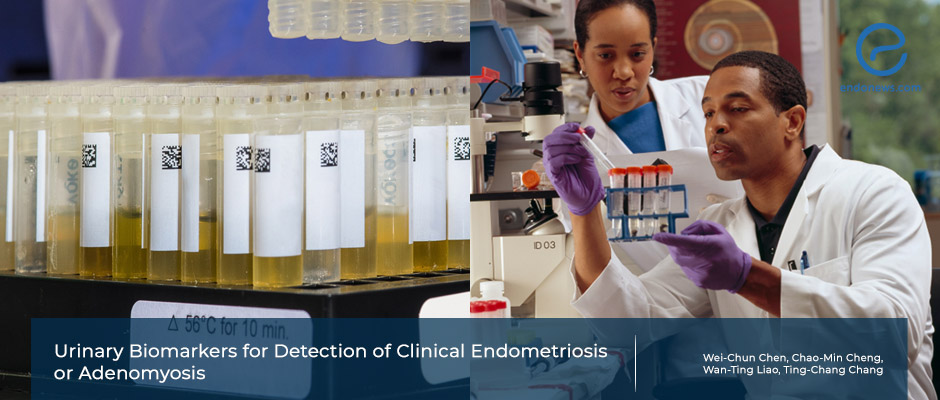How possible is it to diagnose endometriosis from a urine sample?
May 30, 2022
Some urinary biomarkers have provided good results when used as diagnostic tools.
Key Points
Highlight
- Urine samples seem to be a useful non-invasive diagnostic tool in the detection of endometriosis in clinically suspected patients.
Importance
- Although the gold standard in the endometriosis diagnosis is a histopathological examination of a surgical specimen, various biomarkers have been investigated to provide a less invasive approach.
- If proven, these less invasive methods may help in the surveillance compliance in endometriosis with more patients willing to get involved.
What’s done here
- This study aimed to evaluate the utility of urinary biomarkers as a diagnostic tool in endometriosis patients and compare them with serum CA125.
- Urinary levels of Alpha-1 antitrypsin (A1AT), Enolase-1, Vitamin D binding protein (VDBP), and CA125 of 33 patients and 19 controls were measured by ELISA and statistically analyzed.
Key results
- Serum CA125 levels, urinary CA125-creatinine ratio, and urinary VDBP-creatinine ratio were found to be significantly different between the patients and the control group.
- Serum CA125, urine VDBP-creatinine ratio, and urine A1AT-creatinine ratio had a significantly better area under the curve values in the assessment of their diagnostic performances.
- The combination of these three markers also yielded good results.
- The combination of serum CA125 and urine VDBP-creatinine ratio showed excellent results.
- A good sensitivity, positive predictive values, and an accuracy as high as 88% were witnessed with serum CA125 and urinary VDBP ratios in detecting endometriosis clinically.
- The combination of two urinary biomarkers also showed high accuracy rates.
Limitations
- The criteria to differentiate patients with or without endometriosis primarily depended on clinical principles, including clinical symptoms, physical examination, and ultrasound findings, instead of surgical pathologic proof.
- The sample size of the control group is small.
Lay Summary
The development of non-invasive diagnostic methods in endometriosis is essential for successful surveillance. Various biomarkers have been used for this purpose, including biomarkers from serum, peritoneal irrigation fluid, endometrial tissue biopsy, and urine.
Dr. Chen et al. from Taiwan conducted a study in which they assessed the utility of four different biomarkers in the urine in endometriosis and adenomyosis and compared them with the current gold standard biomarker, serum CA125. The study was published in the April 2022 issue of the journal Biomedicines.
The targeted biomarkers comprised Alpha-1 antitrypsin (A1AT), Enolase-1, Vitamin D binding protein (VDBP), and CA125. A total of 33 patients with uterine adenomyosis and/or ovarian endometrioma and 19 controls were included in the study. After urine collection, the biomarker and creatinine levels were measured via enzyme-linked immunosorbent assays. Serum CA125 levels, urinary CA125-creatinine ratio, and urinary VDBP-creatinine ratio were found to be significantly different between the patients and the control group. When the diagnostic performances of these biomarkers were evaluated, Serum CA125, urine VDBP-creatinine ratio, and urine A1AT-creatinine ratio had a significantly better area under the curve values. The combination of these three markers also yielded good results. Moreover, the area under the curve values was excellent when serum CA125 and urine VDBP-creatinine ratio were combined. A good sensitivity, positive predictive values, and an accuracy as high as 88% were witnessed with serum CA125 and urinary VDBP ratios in detecting endometriosis clinically. A combination of two urinary biomarkers also showed high accuracy rates.
The urinary biomarkers are valuable because of the suitability and convenience of taking a urine sample from the patients when compared to other invasive procedures. The authors discussed the potential of ATA1 being used as a biomarker in many other gynecological malignancies and added that the values in the study were shown to have an acceptable power for the use of urinary A1AT levels in detecting endometriosis. They also stated that even though the values of urinary VDBP ratios were not superior to serum CA125, it was still proven to be a useful diagnostic marker. While the authors agree that serum CA125 is a very strong predictor, they conclude that both urinary-A1AT and urinary VDBP may be useful tools in detecting endometriosis with a non-invasive approach.
Research Source: https://pubmed.ncbi.nlm.nih.gov/35453583/
endometriosis urine biomarkers A1AT CA125

